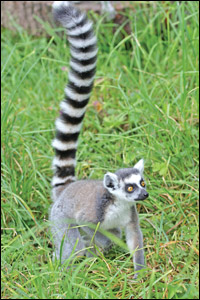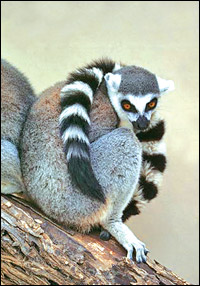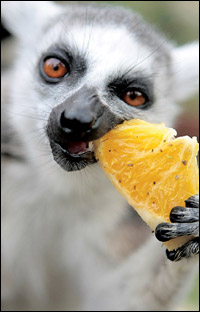Nature
trail
Ring-tailed lemurs:
An endangered species
Like to see some rare species of animal? Then head straight to the
Zoological Gardens of Dehiwela and you will be greeted by three small,
but cute primates that belong to the mammalian group.
  The
most recent addition to the zoo, the ring-tailed lemurs are fascinating
creatures and will undoubtedly attract much attention, even though they
are not as exotic as the two white tigers that were gifted to the zoo
from China. The
most recent addition to the zoo, the ring-tailed lemurs are fascinating
creatures and will undoubtedly attract much attention, even though they
are not as exotic as the two white tigers that were gifted to the zoo
from China.
However, as ring tailed lemurs are an endangered species having not
just one, but three of them at the zoo (two females and a male) will
augur well for the zoo. If they breed in captivity then we could be
proud of being instrumental, even in a small way, in protecting this
endangered species, by increasing its population. Even though the best
place for these little creatures to be in (as it should be for all
animals) is their natural habitat, sometimes it is important and
necessary to protect them even in an enclosure such as a zoo because
today their natural homes are being destroyed by man.
Some of you may have already seen these rare lemurs at the zoo. Today
we like to introduce the animal to you so that you'll be knowledgeable
about the lemur when you visit the zoo someday.
Lemurs, as we mentioned before are primates that are related to
monkeys and apes. But they developed differently from monkeys and apes
when Madagascar separated from the African continent, millions of years
ago.
There are about 22 species of lemurs and the ring-tailed lemurs are
considered unique among them, especially because of their preference to
walk on the ground rather than swing through trees.
The ring-tailed lemurs (Lemur cattas) which are found only in the
African island of Madagascar and some tiny neighbouring islands are also
known by the African names of Hira (Malagasy) and Maki (Malagasy). They
prefer to live in gallery forests and euphorbia bush habitats.
Ring-tailed lemurs who spend a lot of time on the ground (which is
rather unusual for lemurs), could be seen moving about on all fours with
their bottoms sticking up in the air. This is because they have front
legs which are shorter than their back legs. Their body length averages
between 15 and 18 inches (39 to 46 cm). An average adult weighs between
five to eight pounds (2.3 to 3.5 kg). The tails are longer than their
bodies and are about 21.75 in (55 cm).
These tails are what makes them significant among other lemurs
because they are vividly striped in black and white as you can see in
the photographs featured here.

You could see this in the live animals if you make a visit to the
zoo. It would be evident to you by now that these striking tails have
been the reason these animals have been named so.
However, the lemurs cannot use their long tails to grip or hold on to
branches of trees or anything else like the monkeys do.
Lemurs generally use their hands and feet to move nimbly through the
trees in the forests they live in. As lemurs are herbivores and enjoy
eating fruit, leaves, flowers, tree bark and sap they forage for food on
the ground a lot.
Their breeding season is from mid-April through June. After a
gestation period (pregnancy) of four to four-and-a-half months, the
female gives birth to one or two babies at a time.
Lemurs are social and territorial animals. They live in groups which
are called troops. These troops generally have between 6 and 30 lemurs,
but average around 17. A dominant female presides over a troop which
includes both gender. Females stay in the troop in which they were born,
but male lemurs move from troop to troop. The average life span of these
animals in the wild is 16 to 19 years and 27 years in captivity. So, if
we take good care of the three lemurs we have at the zoo, they'll be
with us for a very long time.
  When
looking for a partner, male lemurs battle for dominance by trying to "outstink"
each other. They are famous to cover their tails with smelly secretions
and wave them in the air to decide who is more dominant. Ring-tailed
lemurs have social hierarchies where the females are dominant. When
looking for a partner, male lemurs battle for dominance by trying to "outstink"
each other. They are famous to cover their tails with smelly secretions
and wave them in the air to decide who is more dominant. Ring-tailed
lemurs have social hierarchies where the females are dominant.
These cute animals could be seen sunbathing in the early morning
hours sitting upright with their front legs resting on their back legs -
they look like someone in a meditative pose. When you visit the zoo, see
if you can spot them in this posture.
Ring tailed lemurs are, a closely protected species as their
conservation status is 'near threatened' due to the destruction of
habitat. Like most animals these lemurs too have many predators apart
from man. Some of these native predators are the Fossa (a catlike
predator), Madagascar harrier-hawk, Madagascar buzzard, and the
Madagascar ground boa.
The small Indian civet and the domestic cats and dogs too are a
threat to these animals.
Facts and pix: Internet
*********
Interesting facts
* The ring-tailed lemur's tail is longer than its body.
* If an argument breaks out between a male and female lemur, the
female always wins. The females who are in charge, always get the best
food.
* Lemurs are primates and related to monkeys and apes.
* Lemurs are not able to use their tails to grab onto branches like a
monkey would.
* Fruits make up a larger part of their diet. But sometimes they eat
insects too.
* Male lemurs battle for dominance by trying to 'outstink' each
other.
* The young have blue eyes but adults have yellow or red eyes
depending on the species.
* Lemurs are noisy animals. They make about 15 different kinds of
sounds including purrs, clicks, grunts and howls.
* They also communicate using scent. They mark their territory by
scent.
* Ring-tailed lemurs tend to live in more open and less forested
areas.
********* |

